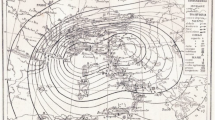Summary
A comparative study of cyclogenesis in the lee of the Andes, the Rockies and the East Asian Mountains, is presented. Using the data of 1958 (the International Geophysical Year) and 1973, it was found that the initial formation of most lee cyclones occurred with the onset of peculiar airflows over the mountains. The lee cyclones usually commenced under the leading (eastern) edge of a diffluent cross-barrier flow in the mid-troposphere superimposed on a zone of low-level convergence and orographic descent. The barrier effects of large-scale mountains were observed to be of great importance to lee cyclogenesis.
It was observed that cyclogenesis in South America occurred most frequently in the lee of the Oliva, Calalaste and Patagonia Cordilleras. Many of the Oliva and Calalaste cyclones were weak and short-lived, while the Patagonia lows were usually migratory with a considerable intensity. Lee cyclones in three continents occurred initially either on a surface front or in a localized baroclinic zone (pseudo front) induced by major mountain ranges.
Zusammenfassung
Eine vergleichende Studie der Zyklogenese im Lee der Anden, der Rocky Mountains und der ostasiatischen Gebirge wird vorgeführt. An Hand der Daten von 1958 (Internationales geophysikalisches Jahr) und 1973 konnte gezeigt werden, daß die Bildung der meisten Lee-Zyklonen mit dem Auftreten gewisser Strömungsbedingungen über den Gebirgen zusammenhängt. Leezyklogenese tritt für gewöhnlich dann auf, wenn der vordere (östliche) Rand einer quer zum Gebirge gerichteten divergierenden Strömung in der mittleren Troposphäre einer Zone von niedertroposphärischer Konvergenz und orographischer Abgleitbewegung überlagert ist. Der Barriereneffekt großer Gebirge ist von bedeutendem Einfluß auf die Leezyklogenese.
Es wurde beobachtet, daß die Leezyklogenese in Südamerika am häufigsten im Lee der Cordilleren von Oliva, Calalaste und Patagonien auftritt. Viele der Oliva- und Calalaste-Zyklonen waren schwach und kurzlebig, während die Patagonien-Zyklonen für gewöhnlich wanderten und beachtliche Intensitäten aufwiesen. Lee-Zyklogenese in den drei Kontinenten trat entweder an einer Bodenfront oder an einer lokalisierten baroklinen Zone (Pseudofront), hervorgerufen durch einen größeren Gebirgszug, auf.
Similar content being viewed by others
References
Bjerknes, J.: On the Structure of Moving Cyclones. Geofys. Publ.,1, No. 2. 8 pp. (1918).
Bjerknes, J.: Theorie der außertropischen Zyklonenbildung. Meteor. Z.,54, 462–466 (1937).
Bolin, B.: On the Influence of the Earth's Orography on the General Character of the Westerlies. Tellus,2, 184–195 (1950).
Chung, Y.-S.: On the Behaviour of Upper Airflows in Large-Scale Mountains. Presented at the Symposium 18-GARP First Objective: Weather Predictability, 16th Gen. Ass. IUGG, Grenoble, 1975, 26 pp.
Chung, Y.-S., K. D. Hage and E. R. Reinelt: On Lee Cyclogenesis and Airflow in the Canadian Rocky Mountains and the East Asian Mountains. Mon. Wea. Rev.,104, 879–891 (1976).
Chung, Y.-S., and E. R. Reinelt: On Cyclogenesis in the Lee of the Canadian Rocky Mountains. Arch. Met. Geoph. Biokl., Ser. A,22, 205–226 (1973).
Egger, J.: Numerical Experiments on Lee Cyclogenesis. Mon. Wea. Rev.,102, 847–860 (1974).
Kawata, Y.: The Influence of the Rocky Mountains on Nonsteady Isobaric Height Patterns. J. Meteor. Soc. Japan,35, 174–183 (1957).
Margules, M.: Über die Beziehung zwischen Barometerschwankung und Kontinuitäts-gleichung. Boltzmann-Festschrift Leipzig, 585–589 (1904).
Manabe, S., and T. B. Terpstra: The Effects of Mountains on the General Circulation of the Atmosphere as Identified by Numerical Experiments. J. Atmos. Sci.,31, 3–42 (1974).
Meteorological Institute. Eurasia Historical Weather Maps for Jan. – Oct. 1958 and Nov.–Dec. 1959. Central Weather Bureau, Peking, 1964.
Newton, C. W. (editor), H. van Loon, J. J. Taljaard, T. Sasamori, J. London, D. V. Hoyt and K. Labitzke: Meteorology of the Southern Hemisphere. Meteor. Monogr.,13, No. 35, 263 pp. (1972).
Palmén, E., and C. W. Newton: Atmospheric circulation systems. Their structure and physical interpretation. Intern. Geophys. Ser. 13, Academic Press, 603 pp., 1969.
Petterssen, S.: Weather analysis and forecasting. Vol. 1, 2nd ed., McGraw-Hill Book Co., N. Y., 428 pp. 1956.
Scherhag, R.: Bemerkungen über die Bedeutung der Konvergenzen und Divergenzen des Geschwindigkeitsfeldes für die Druckänderungen. Beitr. Physik Atmosphäre,24, 122–129 (1938).
Author information
Authors and Affiliations
Additional information
With 3 Figures
Rights and permissions
About this article
Cite this article
Chung, YS. On the orographic influence and lee cyclogenesis in the Andes, the Rockies and the East Asian Mountains. Arch. Met. Geoph. Biokl. A. 26, 1–12 (1977). https://doi.org/10.1007/BF02246530
Received:
Issue Date:
DOI: https://doi.org/10.1007/BF02246530




